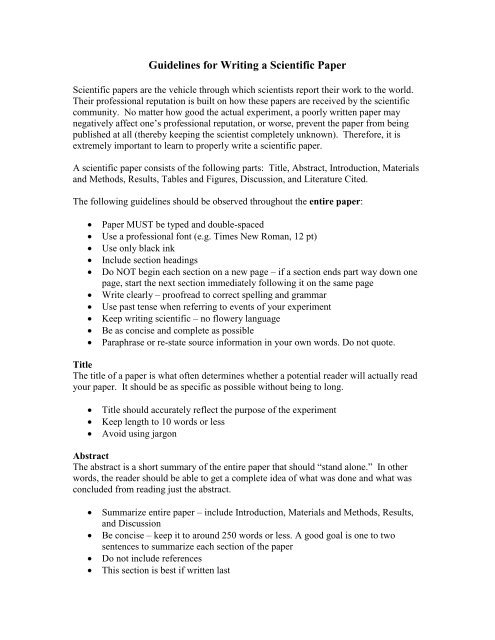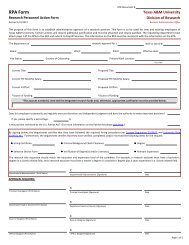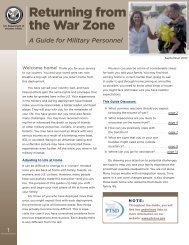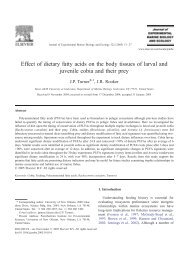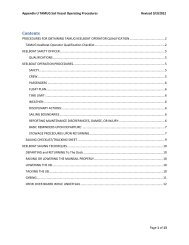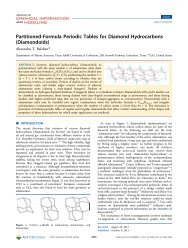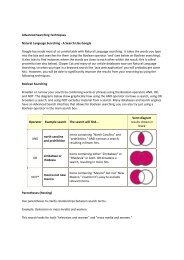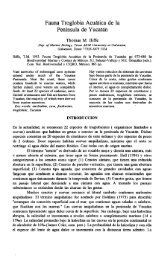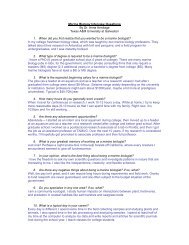Guidelines for Writing a Scientific Paper
Guidelines for Writing a Scientific Paper
Guidelines for Writing a Scientific Paper
You also want an ePaper? Increase the reach of your titles
YUMPU automatically turns print PDFs into web optimized ePapers that Google loves.
<strong>Guidelines</strong> <strong>for</strong> <strong>Writing</strong> a <strong>Scientific</strong> <strong>Paper</strong><br />
<strong>Scientific</strong> papers are the vehicle through which scientists report their work to the world.<br />
Their professional reputation is built on how these papers are received by the scientific<br />
community. No matter how good the actual experiment, a poorly written paper may<br />
negatively affect one’s professional reputation, or worse, prevent the paper from being<br />
published at all (thereby keeping the scientist completely unknown). There<strong>for</strong>e, it is<br />
extremely important to learn to properly write a scientific paper.<br />
A scientific paper consists of the following parts: Title, Abstract, Introduction, Materials<br />
and Methods, Results, Tables and Figures, Discussion, and Literature Cited.<br />
The following guidelines should be observed throughout the entire paper:<br />
<br />
<br />
<br />
<br />
<br />
<br />
<br />
<br />
<br />
<br />
<strong>Paper</strong> MUST be typed and double-spaced<br />
Use a professional font (e.g. Times New Roman, 12 pt)<br />
Use only black ink<br />
Include section headings<br />
Do NOT begin each section on a new page – if a section ends part way down one<br />
page, start the next section immediately following it on the same page<br />
Write clearly – proofread to correct spelling and grammar<br />
Use past tense when referring to events of your experiment<br />
Keep writing scientific – no flowery language<br />
Be as concise and complete as possible<br />
Paraphrase or re-state source in<strong>for</strong>mation in your own words. Do not quote.<br />
Title<br />
The title of a paper is what often determines whether a potential reader will actually read<br />
your paper. It should be as specific as possible without being to long.<br />
<br />
<br />
<br />
Title should accurately reflect the purpose of the experiment<br />
Keep length to 10 words or less<br />
Avoid using jargon<br />
Abstract<br />
The abstract is a short summary of the entire paper that should “stand alone.” In other<br />
words, the reader should be able to get a complete idea of what was done and what was<br />
concluded from reading just the abstract.<br />
<br />
<br />
<br />
<br />
Summarize entire paper – include Introduction, Materials and Methods, Results,<br />
and Discussion<br />
Be concise – keep it to around 250 words or less. A good goal is one to two<br />
sentences to summarize each section of the paper<br />
Do not include references<br />
This section is best if written last
Introduction<br />
The purpose of the introduction is to introduce the reader to your experiment. This is<br />
done by giving some background on the subject in general and explaining why your<br />
particular experiment was per<strong>for</strong>med (what will examining the questions that you<br />
examined add to our body of knowledge on the subject?).<br />
<br />
<br />
<br />
<br />
Start broad by introducing background on the general question/problem at hand<br />
and end narrow with the objectives (purpose) and hypotheses of your particular<br />
study.<br />
Write in paragraph <strong>for</strong>m. This section should have multiple paragraphs.<br />
Background in<strong>for</strong>mation should include references.<br />
State purpose of experiment and hypotheses clearly<br />
Materials and Methods<br />
This section describes to your reader exactly what you did and how you did it. The key<br />
to writing this section is to include enough detail in your description to allow another<br />
scientist to reproduce the experiment simply by reading this section of your paper.<br />
<br />
<br />
<br />
<br />
Written in paragraph <strong>for</strong>m<br />
Do not include a list of materials required – the reader should be able to figure out<br />
what is needed based on the description of the method.<br />
Write in past tense<br />
Include appropriate reference if required<br />
Results<br />
This section summarizes the results of your study in written <strong>for</strong>m. It should contain only<br />
results. All interpretations and explanations of the results belong in the Discussion and all<br />
methods belong in Materials and Methods. Often tables and figures are useful in<br />
presenting results.<br />
<br />
<br />
<br />
<br />
<br />
Keep it simple and concise – especially if tables and figures are used, this section<br />
should not be very long.<br />
There must be some written description of results. Simply referring to tables and<br />
figures is not sufficient.<br />
If any tables or figures are used, they must be referred to AND briefly explained<br />
in the text.<br />
Appropriate way to reference a table or figure: “The temperature of the water<br />
was found to increase with time as demonstrated in Figure 1.” OR “Table 2 lists<br />
absorbance values of the chlorophyll solutions and shows that the most<br />
concentrated chlorophyll solutions had the highest absorbance values.”<br />
Inappropriate way to reference a table or figure: “Results are in tables 1,2 and<br />
figure 1.”
Tables and Figures<br />
Tables and figures can be very helpful in presenting in<strong>for</strong>mation to the reader. They may<br />
be included in the body of the paper, but this is not necessary. It is perfectly acceptable<br />
(and easier) to assign one page per table/figure and include these in the back of your<br />
paper.<br />
All non-table materials are referred to as figures – this includes graphs, maps,<br />
pictures, diagrams, etc.<br />
All tables and figures should have a number, title, and short description.<br />
Number tables and figures independently of each other – e.g. Table 1, Table 2,<br />
Figure 1, Figure 2, etc.<br />
Number tables and figures according to the order in which they are first<br />
mentioned in the text<br />
Tables are labeled at the top; figures are labeled at the bottom.<br />
Titles and descriptions must be self-explanatory – reader should be able to<br />
understand what a table/figure is showing without having to read the text of the<br />
paper<br />
Tables and figures should be neat, easily understood, and correctly summarized<br />
the data<br />
DO NOT present the same results several times over: if a graph summarizes the<br />
trends observed, do not also include the table of data used to create the graph<br />
Discussion<br />
This is the section where you pull everything in the paper together and explain what your<br />
results mean and why they matter. Interpret your results within the context of the<br />
background in<strong>for</strong>mation that you provided in the Introduction. This section will conclude<br />
your paper and thus will be responsible <strong>for</strong> your final impression on the reader.<br />
There<strong>for</strong>e, this section requires a lot of thought and attention.<br />
<br />
<br />
<br />
<br />
<br />
<br />
<br />
Organize this section opposite to the Introduction. Begin narrow by discussing<br />
your specific experiment and end broad by placing your experiment within the<br />
larger context of the general field.<br />
Write in paragraph <strong>for</strong>m. This section should contain multiple paragraphs.<br />
Point out unexpected results and when doing so, be sure to discuss possible<br />
sources of error.<br />
Be specific about sources of error and how exactly a particular error would<br />
influence your results. DO NOT attribute such results to simply “human error”<br />
Compare your results to existing literature.<br />
Clearly state your conclusions and whether the results support or reject the<br />
hypotheses (in doing so, re-state your hypotheses)<br />
Make sure the paper ends appropriately<br />
Literature Cited<br />
All references MUST be properly cited both within the text and the literature cited<br />
section. To properly cite your materials, follow the guidelines set <strong>for</strong>th <strong>for</strong> you in the<br />
“Citing References” handout you received at the beginning of the semester.
Citing References<br />
In-text Citations<br />
Whenever a researcher mentions in<strong>for</strong>mation that they did not personally obtain through<br />
experimentation of observation, the MUST include a reference indicating the source of<br />
in<strong>for</strong>mation i.e. they must cite the reference. When citing a reference within the text of a<br />
report, it is suffiient to list only the author and year of publication. The complete<br />
reference is then found in “Literature Cited.”<br />
Reference cited be<strong>for</strong>e or after in<strong>for</strong>mation:<br />
Smith and Dirt (2000) found that sea otters preyed on abalone and clams.<br />
Sea otters prey on abalone and clams (Smith and Dirt, 2000).<br />
Single reference <strong>for</strong> multiple pieces of related in<strong>for</strong>mation (listed one after another in<br />
same paragraph):<br />
Black bears in Alaska were found to hibernate from November to April. Males<br />
lost an average of 37 kg, while females lost an average of 42 kg. This difference<br />
in weight loss was attributed to the fact that females gave birth prior to<br />
hibernation, and suckled cubs during the winter months (Rhodes, 1997).<br />
Multiple references <strong>for</strong> multiple bits of in<strong>for</strong>mation (within the same sentence) or<br />
multiple references <strong>for</strong> the same bit of in<strong>for</strong>mation.<br />
It has been found that weiner dogs (Jordan, 1965), small kick dogs (Sam and<br />
Flueglehorn, 1981; Joshii and Johii, 1989; Thompson, 1995)* and spotted dogs<br />
(Bertrand, 1999) prefer tofu to steak.<br />
*Note: list multiple references in date order within each set of parentheses.<br />
Reference with 3+ authors:<br />
Albatross suffering from droop-wing were found to have ingested paint chips<br />
containing lead (Pink et al., 1998)*<br />
Note: “et al.” is in italics. Complete reference listing all authors found in<br />
Literature Cited.<br />
(“et alli” is Latin <strong>for</strong> “and others”)<br />
Personal Communication:<br />
light.<br />
Smith (personal communication) has shown that manatees do not react to bright<br />
Note: Personal communications are not listed in Literature Cited.
Literature Cited<br />
All references cited within the text of a paper/report must be listed in the “Literature<br />
Cited” section. References should be listed in alphabetical order by first author. Within a<br />
reference, the order of authors should remain the same as the order they are listed on the<br />
publication.<br />
Book/text:<br />
Peeler, A.M. and R.D. Lark. 1998. Biology Laboratory Manual. John Wiley and<br />
sons, Inc., New York.<br />
Chapter from a book, where a different author writes each chapter:<br />
Green, M.A., P.Q. Marks, P.D. Bloom, and G.L. Fretful. 1999. Building wooden<br />
bridges. In: Modern Engineering Marvels, E.P. Rerents and K.L.<br />
Stricknine, Eds. Pp. 34-62. Springer-Verlag, New York.<br />
Article from a published journal:<br />
Laurens, M.A. and D.B. Rutgers, 1972. Physiological and morphological<br />
adaptations to a subterranean existence in the naked mole rat. Journal of<br />
Zoology 72: 1322-1327.<br />
More than one reference by the same author:<br />
Gunter, G. 1941a. Occurrence of the manatee in the United States, with records<br />
from Texas. Journal of Mammalogy 22:60-64.<br />
________. 1941b. Death of fishes due to cold on the Texas coast, January 1940.<br />
Ecology 22:203-208.<br />
________. 1942. Contributions to the natural history of the bottlenose dolphin,<br />
Tursiops truncatus (Montague), on the Texas coast, with particular<br />
reference to food habits. Journal of Mammalogy 23:267-274.<br />
Note: multiple references by the same author are list in order of year.


